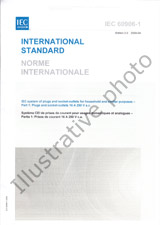We need your consent to use the individual data so that you can see information about your interests, among other things. Click "OK" to give your consent.

IEC 62899-501-1-ed.1.0
Printed electronics - Part 501-1: Quality assessment - Failure modes and mechanical testing - Flexible and/or bendable primary or secondary cells
Translate name
STANDARD published on 16.1.2019
The information about the standard:
Designation standards: IEC 62899-501-1-ed.1.0
Publication date standards: 16.1.2019
SKU: NS-935984
The number of pages: 15
Approximate weight : 45 g (0.10 lbs)
Country: International technical standard
Category: Technical standards IEC
The category - similar standards:
Primary cells and batteriesAlkaline secondary cells and batteriesOther cells and batteries
Annotation of standard text IEC 62899-501-1-ed.1.0 :
IEC 62899-501-1:2019(E) specifies failure modes and mechanical stress test methods for the determination of reliability characteristics of bendable or flexible printed primary cells and secondary cells and batteries as defined in IEC 60050-482:2004, 482-01-01, IEC 60050-482:2004, 482-01-02, IEC 60050-482:2004, 482-01-03, IEC 60050-482:2004, 482-01-04 and IEC 60050-482:2004, 482-01-05, respectively. Important parameters and specifications for primary cells are mentioned in IEC 60086-1 and IEC 60086-2. IEC 61960-3, as well as IEC 61951-1 and IEC 61951-2 define performance tests, designations, markings, dimensions and other requirements for secondary single cells and batteries. IEC 62133-1 and IEC 62133-2 address general safety requirements of secondary cells and batteries.
We recommend:
Technical standards updating
Do you want to make sure you use only the valid technical standards?
We can offer you a solution which will provide you a monthly overview concerning the updating of standards which you use.
Would you like to know more? Look at this page.



 Cookies
Cookies
